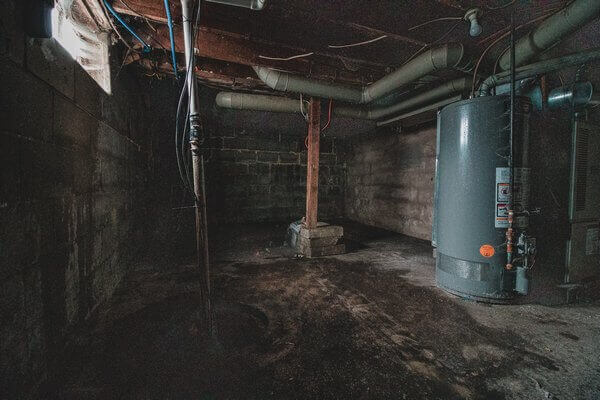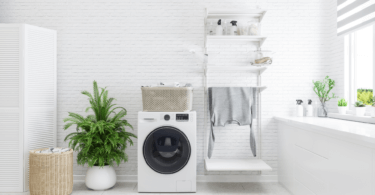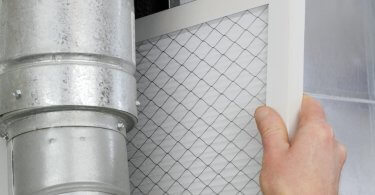Dank, musty, and stuffy – do those words remind you of your basement? If they do, then you’ve got a poorly ventilated basement. Luckily, there are many ways you can resolve this.
So if you’re wondering how to ventilate a basement, give this basement ventilation guide a quick read. From easy and simple methods to costly and more effective ones, we’ll discuss all the ways to battle basement ventilation issues below. Read on to know more!

Why You Should Ventilate Your Basement
If you’ve ever felt suffocated after stepping inside your basement, perhaps, the air in there is very moisture-laden. This happens due to several reasons – rain, laundry, cooking, moisture seeping through the concrete, etc.
Humid air can weaken and damage your basement’s foundation. Moreover, it can lead to mold growth – something that you need to avoid at all costs. Mold can cause severe health issues if left undetected, and can further rot and damage your basement and the stuff inside.
Read also: How To Kill Mold With Temperature?
Apart from this, poor basement air circulation systems can lead to radon gas accumulation – another thing you must avoid. Radon gas is a natural by-product of rock and soil decaying under your basement and can lead to dire health consequences.
Read Also: Do Air Purifiers Help With Radon Gas
And to make things worse, boilers, generators, and other such things can cause carbon monoxide build-up in basements. This gas is also dangerous to inhale and can make working in the basement very uncomfortable.
You can avoid all these structural and health issues by adequately ventilating your basement. This ensures the longevity of any appliances, walls, and flooring in your basement. It also helps give your basement a comfortable and homey feel.
4 Tips on How to Ventilate a Basement
Ventilating a basement is not an easy task, but it’s not too difficult either. Here are four ways you can do so.
1. Natural Method
If you’re lucky, you won’t have to buy expensive devices to ventilate your basement. Instead, you can use what you already have:
Windows
Most basements have windows that open outside, above the ground. If your basement is humid and full of stale air, you should open up these windows to let in some fresh air. If you have more than one window, open all of them to enable cross-ventilation.
In case you don’t have any windows, consider installing one. Yes, the process might be a bit expensive, but windows are necessary for ventilation. They also help with installing other stuff like exhaust fans. Just make sure you install windows at a location where they’re protected from rain or snow.
While opening windows may be the easiest and quickest solution, it does require some monitoring. For instance, you’ll have to manually open and close the windows and keep an eye out for weather changes.
Doors
Open up the door to your basement to let in some air from inside your house. You can pair this with other methods described below.
2. Mechanical Method
For the question, how to ventilate a basement, one of the most effective solutions is mechanical ventilation.
Box Fan
An affordable way to create ventilation is to get a box fan, which creates air flow within a room. They’re small, portable, and don’t cost a lot either.
However, depending on your basement’s size, you may need to buy more than one box fan. If you have a large basement, consider getting standalone fans, which are more powerful.
See Related: Electricity Usage of a Box Fan
Exhaust Fan
Most enclosed spaces have exhaust fans to prevent stuffiness. These fans suck out the stale air present inside a room, creating a negative pressure in the area. In effect, new and fresh air is forced to come in.
It would be best if you use exhaust fans along with a natural method of ventilation, so there’s a way for fresh air to travel inside your basement.
Also, if you have a basement without windows or vents, you’ll have to cut a hole through the wall to fit the exhaust fan – a costly and time-taking task, but worth it.
Air Conditioning
If you’re wondering about how to ventilate a basement more effectively, a window air conditioning unit can do the job. These units are cheap and easy to install, so if your basement has a window, this is the way to go.
If your basement is large, consider installing an additional HVAC system to support your basement’s ventilation needs. This option is pretty costly as it involves new ductwork installation (if there isn’t any already) and buying another HVAC system.
On the bright side, an HVAC system can monitor a room’s temperature and humidity on its own, so if you want a solution that requires low maintenance and less fuss, this might be a smart idea.
You can also get a ductless mini-split for efficient ventilation. These air conditioners are pricier than window units but cheaper than an HVAC. And the good news is that they don’t need additional ductwork to be installed and can support large rooms.
Related Post: Portable vs Window Air Conditioners Comparison
3. Dehumidifier
Most basements are humid, which makes them very stuffy, and fans alone can’t reduce humidity. To dry the air, you’ll have to purchase a basement dehumidifier. This will effectively remove any moisture that accumulates in your basement, ensuring a comfortable environment inside.
Once you’re done running the dehumidifier, you can open doors and windows to let in some fresh air.
Also, make sure you know what size is suitable for your basement. Most of the time, basements require an industrial size unit, especially if they tend to have frequent condensation and leaks.
Read Also: Air Purifier or Dehumidifier For Mold
4. Air Purifier
If you want to keep circulating the air within your basement, investing in an air purifier might be a good idea.
Air purifiers suck in air present inside a room and pass it through a series of filters. These filters capture dust, mold spores, and pathogens. After this, it pushes out the clean and fresh air into the room and continues the cycle.
Adding an air purifier to your basement will also prevent mold spores from settling down on any surface. So if your basement doesn’t have high humidity but suffers from stagnant and stale air, consider purchasing an air purifier.
Must Read: 5 Best Air Purifiers for Mold & Mildew Review
Final Words
Ventilating a basement can be as easy as opening windows or as complicated as installing a new HVAC system, depending on your basement’s construction. Either way, you should always ensure ventilation to prevent damage and mold growth.
Once you do so, you’ll find your basement to be much fresher and livelier, and it might even lead you to consider making it a part of your living quarters.




